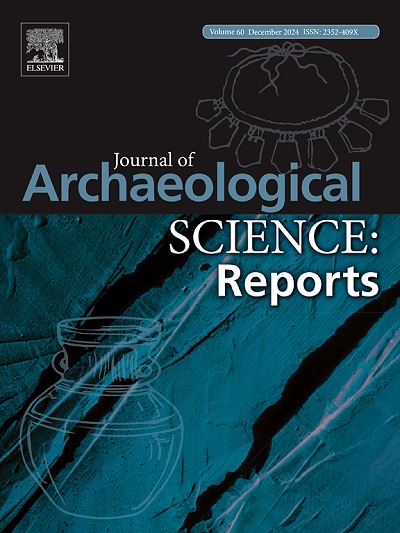对中世纪早期希腊手工器皿研究的岩石学贡献:以波奥提亚和阿该亚为例
IF 1.5
2区 历史学
0 ARCHAEOLOGY
引用次数: 0
摘要
拜占庭“黑暗时代”(公元7 -9世纪)的开始通常标志着古代的结束,作为一个新的,但漫长的,阴沉的时期的过渡,改变了东地中海社会生活的各个方面(Haldon, 1990, Karayannopoulos, 2001;Vionis, 2020)。在拜占庭帝国遭遇的众多“不幸”中,斯拉夫部落向巴尔干半岛最南端地区的推进和定居被学者们反复讨论为中世纪早期希腊大陆的关键事件之一(avramsamac, 1997, Charanis, 1950, Koder, 2020)。在传统的物质文化中,这种下降以一种被称为斯拉夫器皿的手工器皿为例,这种器皿从6世纪晚期开始在各种环境中被发现(Anagnostakis和Poulou-Papadimitriou, 1997, Aupert, 1980, Gallimore et al., 2022, Gregory, 1993;Vida and Völling, 2000)。尽管它特别有趣,但很少有人注意到这种陶器,它经常在考古报告中提到,但通常被忽视。然而,最近的许多研究(例如,城市中心、堡垒、墓地、救援挖掘发现)对这些容器的类型做出了很大贡献(Athanasoulis和Vassiliou, 2009, Athanasoulis和Vassiliou, 2014, Aupert, 1980, Vida和Völling, 2000;Vikatou, 2002;Zachariadis, 2014年,Zachariadis, 2021年),但它们在分析性陶器研究中几乎是缺席的。在本文中,来自两个地区的样本,希腊中部的Boeotia省(Bintliff, 2012, Vionis, 2008, Vionis, 2017, Vionis和Loizou, 2017)和Achaea的Kamenitsa地区,提供了“斯拉夫”传统手工陶器的代表性组合。通过尝试宏观到微观的方法,本研究通过TL-OM对这种陶器的技术和组成特征提出了一些初步的评论,并希望开始讨论手工陶器技术、“斯拉夫”陶器传统、人口流动以及拜占庭中世纪早期模式和风格的适应等方面。本文章由计算机程序翻译,如有差异,请以英文原文为准。
A petrographic contribution to the study of handmade vessels from Early medieval Greece: A case-study from Boeotia and Achaea
The beginning of the Byzantine ‘Dark Ages’ (7th-9th cent. CE) conventionally signify the end of Antiquity, as the transition to a new, yet prolonged, dismal period that transformed every aspect of life for the societies in the Eastern Mediterranean (Haldon, 1990, Karayannopoulos, 2001; Vionis, 2020a). Amongst the many ‘misfortunes’ to befall upon the Byzantine Empire, the advance and settlement of Slav tribes into the southernmost regions of the Balkan peninsula have repeatedly been discussed by scholars as one of the key events of the Early Middle Ages in mainland Greece (Avraméa, 1997, Charanis, 1950, Koder, 2020). Traditionally in material culture, this descent is exemplified by a type of handmade vessels, known as Slav ware, and found in various contexts from the late 6th century onwards (Anagnostakis and Poulou-Papadimitriou, 1997, Aupert, 1980, Gallimore et al., 2022, Gregory, 1993a; Vida and Völling, 2000).
Despite its particular interest, little attention has been drawn on this pottery, often mentioned in archaeological reports, though generally overlooked. However, numerous studies recently (e.g. urban centres, fortresses, burial sites, rescue excavation findings) have contributed greatly to the typology of these vessels (Athanasoulis and Vassiliou, 2009, Athanasoulis and Vassiliou, 2014, Aupert, 1980, Vida and Völling, 2000; Vikatou, 2002; Zachariadis, 2014, Zachariadis, 2021), yet they remain almost absent from analytical pottery studies. In this paper, samples from two regions, the province of Boeotia in central Greece (Bintliff, 2012, Vionis, 2008, Vionis, 2017, Vionis and Loizou, 2017) and the area of Kamenitsa in Achaea, provide a representative assemblage of handmade pottery of the ‘Slav’ tradition. By attempting a macro to micro approach, this study presents some preliminary remarks regarding technological and compositional characteristics of this ware through TL-OM and aspires to initiate a discussion on aspects of handmade pottery technology, the ‘Slav’ ware tradition, population movement and the accommodation of modes and styles in the Byzantine Early Middle Ages.
求助全文
通过发布文献求助,成功后即可免费获取论文全文。
去求助
来源期刊

Journal of Archaeological Science-Reports
ARCHAEOLOGY-
CiteScore
3.10
自引率
12.50%
发文量
405
期刊介绍:
Journal of Archaeological Science: Reports is aimed at archaeologists and scientists engaged with the application of scientific techniques and methodologies to all areas of archaeology. The journal focuses on the results of the application of scientific methods to archaeological problems and debates. It will provide a forum for reviews and scientific debate of issues in scientific archaeology and their impact in the wider subject. Journal of Archaeological Science: Reports will publish papers of excellent archaeological science, with regional or wider interest. This will include case studies, reviews and short papers where an established scientific technique sheds light on archaeological questions and debates.
 求助内容:
求助内容: 应助结果提醒方式:
应助结果提醒方式:


